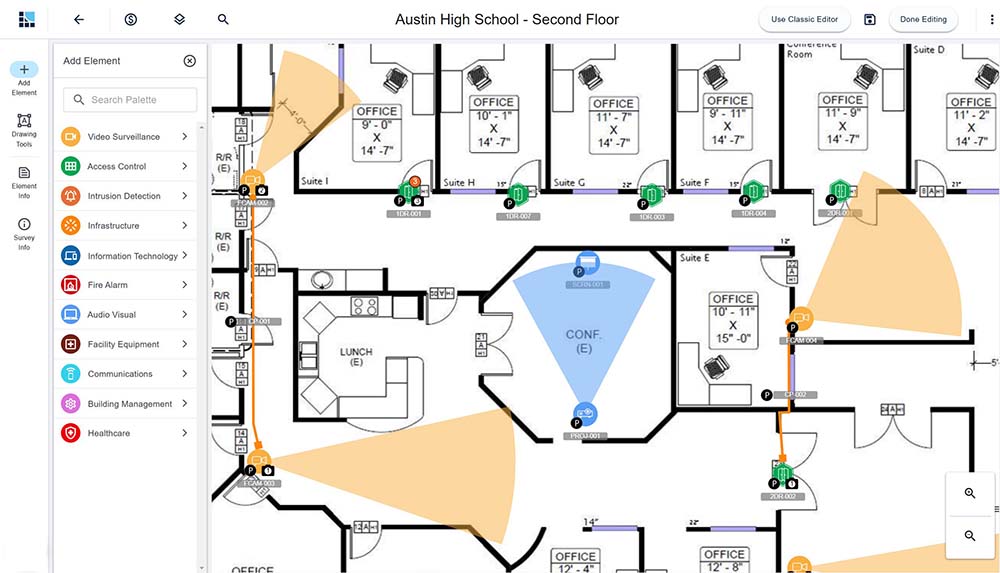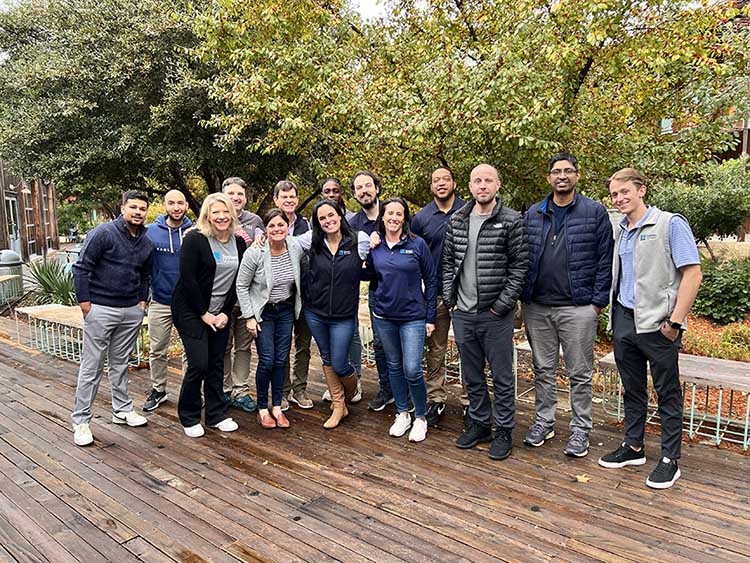A Glance Back & Look Ahead with Chris Hugman, System Surveyor Co-Founder and CEO
As we approach the end of the year, all of us at System Surveyor are brimming with excitement about what lies ahead. This year has been a significant one in the physical security and low voltage industries, and 2025 looks to be a year full of unique opportunities and continued industry evolution.

Co-Founder and CEO of System Surveyor Chris Hugman is a thought leader in electronic security and networking technology, with decades of experience spanning physical security, tech and engineering. He’s one of the visionaries who, a decade ago, saw the potential for reinventing security system design to be digital, visual and collaborative. This vision led to System Surveyor and continues to fuel our ongoing innovation today.
I recently sat down with Chris to get his insights, both his perspective on the year that’s wrapping up and what he’s expecting in 2025.
Q: 2024 was an interesting year in physical security. What are some of the trends you’ve seen?
A: Great question! I’ve noticed five main trends in physical security in 2024.
Growth: First, I’ve seen the security industry continue to grow at a steady clip. That’s a great thing for anyone in this business, but some are benefiting from this growth more than others. We’ve seen security technology companies and system integrators that are leading with innovative products and services outpace the rest. They’re taking advantage of the overall physical security industry/market growth, capturing three or four times the average growth rate in the industry.
M&A: We’ve also seen an increase in mergers and acquisitions (M&A) activity. The investment community has taken a closer look at the physical security industry, looking to benefit from the pace of growth. We’ve seen larger national firms buying up local and regional system integrators at a faster rate than usual. Overall, I view this as positive because it drives change and creates new opportunities.
Standardization: The third trend I’ve noticed is the way more and more companies are standardizing around a cohesive digital strategy. As companies grow larger, scalability becomes a bigger concern, which in turn leads to process improvement initiatives. A big benefit of this move toward standardization and digitization is improved continuity throughout the customer lifecycle to capitalize on customer lifetime value and recurring revenue. Site surveys and system design, implementation and long-term support and maintenance all work more effectively when using standardized processes and collaborative digital platforms.
AI/ML: Fourth, AI and machine learning. A lot of the early hype was more marketing bluster than real-world change. But 2024 brought improved clarity about where we really are and what AI can and cannot do right now and in the near term. AI has plenty of value to deliver, and this will grow substantially over time. The challenge for everyone is how to leverage new AI capabilities to deliver real value to the customer so that AI becomes more than just a marketing tactic.
Collaboration: My last observation is about collaboration between system integrators, manufacturer vendors and end users. As technology grows more sophisticated, all parties need a common language and set of technology tools to promote joint success. Manufacturers are recognizing the need for strong system integration partners, so there’s exciting ongoing work happening there.

Q: Let’s zoom in on #3, standardization. Why do you think this is happening, and why right now?
A: First, let me say that this is a complex industry, in ways that tend to resist standardization. No two buildings are the same, no two end customers are the same, and so on.
But for too long, I think the physical security industry has gotten by on the commitment and ingenuity of our security professionals alone. While those are certainly admirable attributes, they only take a company so far, thus the need to bring in standards for both companies and for the industry.
The physical security industry is starting to see numerous advantages to standardizing, including:
- Operational efficiency
- Improved customer experience
- Better measurability – using data more for strategic decisions
- Higher quality – reduced errors and oversights
- Better scalability – enables new people to contribute quickly
- Profitability
As far as “why right now?”, I think the answer is technology. When system integrators had no real choice but to handwrite their site survey notes, standardization wasn’t feasible and wouldn’t have helped all that much. But now that security integrators have cloud-based collaborative tools like System Surveyor available to them, meaningful standardization is possible.
Q: Can you expand on how collaboration has improved in 2024? How is that playing out?
A: Fundamentally, the difference between a mediocre team and a high-performing team is collaboration. Working together with everyone on the same page, everyone has the same information— that’s game-changing.
But here’s the thing: it’s difficult to collaborate like this using pen-and-paper methods or with lengthy textual scope of work descriptions. And, it’s been challenging to digitally collaborate with external stakeholders due to security concerns. That’s why enabling secure collaboration is so important for us.
So, what we’ve done is add an interactive visual component to the collaboration. When teams collaborate over a visual map, everyone processes the information shared much more quickly so the benefits increase exponentially. Everyone can get on the same page — or the same digital floor plan — because that’s how the System Surveyor platform is built.
This really is a case of “a picture is worth a thousand words.” Except our “picture” is data-rich, editable and updates in real time. It’s just a completely different level of shared information compared to text-only scope of work or a static PDF.
Q: In terms of what’s coming in 2025, what trends do you expect we’ll see?
A: Growth in our industry looks like it will stay strong, and the increased M&A activity will likely continue, driving new opportunities.
I think it’s clear that companies will keep refining and streamlining their processes, along with their tech stack, to modernize operations and enable scalability. It’s like the idea of doing more with less, but from a more strategic standpoint.
We’ve already started to see an increase in the convergence between physical security, IT, and AV — in fact we published an article on this just a few weeks ago. I expect this to continue and accelerate, likely happening more rapidly than before. As all three of these fields grow in and convergethe lines between them are getting blurry and customers are asking integrators to do more of the work in these related and technically complex areas.. That provides an opportunity for system integrators to expand across vertical industries, which is an exciting growth avenue for some of our customers.
I think in 2025 we’ll also see some further refinements in how AI benefits the physical security industry. AI devices need to be designed properly to take advantage of what’s now possible, but also deliver real value for this market. More of them will use chips from the likes of NVIDIA and offer the next level of processing power. Right now, the intersection between physical devices and AI capabilities is in its infancy; I hope 2025 sees it start to mature.
Last, we’ve seen a strong degree of interest from key security industry players to work together in terms of building business to business SaaS software application integrations. No official announcements just yet, but we’re excited at the prospect of finding new ways to support our community of users.A:
Q: How will System Surveyor help the industry prosper in 2025?
A: We’re really excited about expanding the ways we empower the physical security industry in the coming months. As systems become more complex, the need to simplify the processes behind the systems becomes more important. That’s our focus when we talk about unlocking the potential for IoT professionals.
We empower them with easy-to-use site surveys and collaborative security system design so they can look more professional and provide more value. We’re seeking to help our clients create ongoing value for their customers and create high-value recurring revenue services for themselves in the process. We’re thinking specifically about maintenance plans and service level agreements that work well and drive greater lifetime value from customers. System Surveyor enables users to quickly and easily surface detailed customer information, which simplifies the process of providing valuable ongoing support.
Q: What’s new on the horizon for System Surveyor itself? What are you most excited about for 2025, product-wise?
A: We’ve spent the last couple of years on a fundamental refactoring of our platform, and we’re excited to see that work come to fruition. System Surveyor was already providing tons of value to users, but our gradual rollout of System Surveyor 2.0 provides even more.
We’ve already released System Surveyor 2.0 for our tablet app, and most of our customers are now using it for conducting site surveys and system design work with their customers in the field. Next up is System Surveyor Web Editor 2.0, which is a reimagining of the System Surveyor web/desktop experience. This is coming in December 2024, and when it goes live, version 2.0 will be complete. At that point, the two user interfaces will match, and features will be seamless between them. When you come back from a site survey and open your security system design in our Web Editor 2.0, you’ll see the same familiar interface you were just using on your tablet and can switch over seamlessly.

This new version has been a major investment for us, with lots of enhancements that users have been asking for. It should be an exciting evolution for our users, one that is truly beneficial. We are now in a position to evolve the platform more quickly than ever before.
Additionally, we’ll be unveiling our System Surveyor Certification program in Q1, 2025 which provides the opportunity for deeper knowledge and expertise for our System Surveyor user community. More companies are looking to these certifications to ensure their team is positioned to succeed.
I’ve also been excited to see how well our team is gelling. We’re a lean but mighty group, and I’m so grateful for them. We’re well positioned to help our customers unlock their potential in 2025.

Many thanks to Chris for sharing his insights. All of us at System Surveyor are excited for the final phase of System Surveyor 2.0 to go live, and we can’t wait to show it to you. If you’re a current user, you’ll see the updated rollout soon. And if you’re not yet using System Surveyor, we’d love to show you how it can redefine what’s possible for streamlining your site surveys and security system designs.

Maureen Carlson is co-founder and president of System Surveyor, the leading digital platform for physical-security site surveys and system design. With 25 + years in B2B SaaS and security technology, she leads the go-to-market and operations with a top notch team. Under her leadership, System Surveyor has grown into an industry-defining software used worldwide to streamline system design, enable collaboration, and raise the bar for security and technology professionals. Maureen enjoys building relationships in the industry and user community to build sustainable, high growth business. In her spare time in beautiful Austin, you’ll find her spending time outdoors, on a tennis court, reading or with family and friends.
